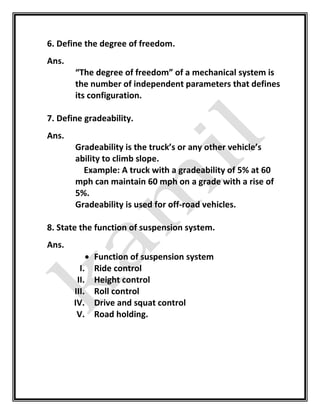Vehicle kinematics and dynamics (vkd) short answer for gtu
- 1. VEHICLE KINEMATICS AND DYNAMICS Short answers:- 1. What is dynamics? Ans. Dynamics is the branch of classical mechanics concerned with the study of force and their effects on motion. Or It deals with the force and their effects while acting upon a body in motion. 2. Write down the classification of link. Ans. I. Rigid link II. Flexible link III. Fluid link IV. Simple and compound link. 3. Write down the various type of cam. Ans. ď‚· Type of cam I. Wedge cam II. Flat cam III. Radial cam IV. Cylindrical or Drum cam.
- 2. 4. State different types of suspension spring. Ans.  Type of suspension spring I. Coil spring II. Leaf spring III. Air spring IV. Torsion bar 5. What is traction and tractive effort? Ans.  Tractive effort The existing force between drive wheel’s tyres and road surface that force is known as tractive effort.  Traction The ability of the drive wheels to transmit this effort or “tractive effort” without slipping.
- 3. 6. Define the degree of freedom. Ans. “The degree of freedom” of a mechanical system is the number of independent parameters that defines its configuration. 7. Define gradeability. Ans. Gradeability is the truck’s or any other vehicle’s ability to climb slope. Example: A truck with a gradeability of 5% at 60 mph can maintain 60 mph on a grade with a rise of 5%. Gradeability is used for off-road vehicles. 8. State the function of suspension system. Ans.  Function of suspension system I. Ride control II. Height control III. Roll control IV. Drive and squat control V. Road holding.
- 4. 9. Define the term kinematics. Ans. ď‚· Kinematics It deals with the bodies in motion without any reference to the force which are responsible for the motion. 10. Draw neat sketch of slider crank mechanism. Ans. This type of chain inversion is used in reciprocating steam engine and internal combustion engine. As the figure show this type of mechanism converts the reciprocating motion into rotary motion of crank. Link 1 is fixed which is compatible with the frame of engine, link 2 is crank, link 3 is connecting rod and link 4 is a piston.
- 5. 11. Difference between Rigid link and flexible link. Ans. Rigid link Flexible link 1) In this type of link there is no deformation while transmitting the motion. 1)In this type of link there is partial deformation while transmitting the motion. 2) Example : motion between piston & crank. 2)Example: belt drive 12. What is inversion of mechanism. Ans. Inversion of mechanism: It is a mechanism in which one of the links of a kinematic chain is fixed. Different mechanisms can be obtained by fixing the different links of the same kinematic chain. The inversion of a mechanism does not change the motion of its links relative to each other.
- 6. 13. Define the terms Ans. I. Free vibration: Free vibrations are oscillation where the total energy stays the same over time. This means that the amplitude of the vibration stays the same. II. Forced vibration: Forced vibration occurs when the object is forced to vibrate at a particular frequency by a periodic input of force. 14. Draw the neat sketch of any two types of follower. Ans.
- 7. 15. Define ď‚· Frequency: The number of speed cycle in the unit is called frequency. In MKS system it is written as cycle per second & in SI system. Hz is the unit. ď‚· Amplitude: The maximum displacement from its normal position during a cycle in the vibrating system is called amplitude. ď‚· Cycle: The cycle that is completed in one time period is called cycle. 16. Draw Four bar mechanism.








